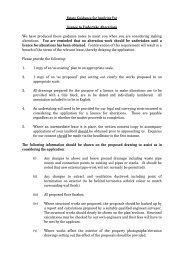The best of Chelsea by the people who know - Cadogan
The best of Chelsea by the people who know - Cadogan
The best of Chelsea by the people who know - Cadogan
Create successful ePaper yourself
Turn your PDF publications into a flip-book with our unique Google optimized e-Paper software.
23 | STREETS & SIGHTS |<br />
Hans Town<br />
<strong>The</strong> area <strong>of</strong> <strong>Chelsea</strong> that was <strong>know</strong>n as<br />
Hans Town has been frequented <strong>by</strong> many<br />
remarkable characters, including authors<br />
Jane Austen, Lady Caroline Lamb and<br />
Mary Mitford.<br />
Henry Holland <strong>the</strong> builder and his son,<br />
Henry Holland <strong>the</strong> architect, put forward<br />
plans in 1771 to develop 89 acres <strong>of</strong> fields<br />
and market gardens between<br />
Knightsbridge in <strong>the</strong> north and Blacklands<br />
— what is now Turks Row, behind <strong>the</strong><br />
Saatchi Gallery — in <strong>the</strong> south. It was an<br />
ambitious scheme. To put it in perspective,<br />
<strong>the</strong> £2 billion regeneration <strong>of</strong> King s Cross<br />
which is destined to deliver 2,000 homes,<br />
500,000 sq ft <strong>of</strong> retail and 3.4 million sq ft<br />
<strong>of</strong> <strong>of</strong>fices, covers only 67 acres.<br />
<strong>The</strong> Holland scheme — <strong>know</strong>n as Hans<br />
Town after Sir Hans Sloane, <strong>who</strong>se heirs<br />
owned <strong>the</strong> land — became <strong>the</strong> model for<br />
many new towns in central London during<br />
<strong>the</strong> building boom in <strong>the</strong> 18th and 19th<br />
centuries.<br />
Work on Hans Town began in 1777, and<br />
<strong>by</strong> 1790, spacious three-storey Georgian<br />
terraces lined <strong>the</strong> west side <strong>of</strong> Sloane<br />
Street and flowed into Hans Place, Hans<br />
Street and Hans Crescent.<br />
<strong>The</strong> buildings had been let on 99-year<br />
leases and when <strong>the</strong> leases came to an<br />
end, <strong>the</strong> <strong>Cadogan</strong> Estate launched a redevelopment<br />
programme in a style that art<br />
critic, author and cartoonist Osbert<br />
Lancaster described as Pont Street Dutch .<br />
<strong>The</strong> red-brick buildings, with <strong>the</strong>ir large windows,<br />
ornamentation and gables, are<br />
instantly recognisable.<br />
Sloane Place<br />
Henry Holland <strong>the</strong> architect built himself a<br />
mansion south <strong>of</strong> Hans Place, set in three<br />
acres, and had moved in <strong>by</strong> 1789.<br />
Pont Street Dutch gables<br />
Originally called Sloane Place, it became<br />
<strong>know</strong>n as <strong>the</strong> Pavilion because <strong>the</strong> front<br />
<strong>of</strong> <strong>the</strong> house was built as a model for <strong>the</strong><br />
Brighton Pavilion, with a Doric column<br />
colonnade.<br />
<strong>The</strong> south <strong>of</strong> <strong>the</strong> mansion looked over<br />
landscapes designed <strong>by</strong> ‘Capability’<br />
Brown, Holland s fa<strong>the</strong>r-in-law and partner.<br />
<strong>The</strong> gardens featured a Gothic icehouse<br />
and a faux ruined priory, created<br />
using stones from <strong>the</strong> demolished home<br />
<strong>of</strong> Cardinal Wolsey.<br />
<strong>The</strong> Pavilion was demolished during<br />
<strong>the</strong> 19th-century redevelopment, but is<br />
commemorated in <strong>the</strong> name <strong>of</strong> Pavilion<br />
Road. <strong>Cadogan</strong> Square was laid out in<br />
part <strong>of</strong> <strong>the</strong> gardens.<br />
22 Hans Place<br />
22 Hans Place was a school in 1978,<br />
attended <strong>by</strong> Lady Caroline Lamb, novel-<br />
ist Mary Russell Mitford and journalist,<br />
poet and novelist Letitia Landon, <strong>who</strong><br />
was <strong>know</strong>n <strong>by</strong> her initials, LEL.<br />
Lady Caroline Lamb (1785-1828)<br />
married <strong>the</strong> future prime minister, <strong>the</strong><br />
2nd Viscount Melbourne, and is <strong>best</strong><br />
<strong>know</strong>n for her affair with Lord Byron. She<br />
famously described Byron as, mad, bad<br />
and dangerous to <strong>know</strong>.<br />
Mary Mitford (1787-1855), <strong>who</strong> wrote<br />
Our Village, was a friend <strong>of</strong> Elizabeth<br />
Barrett Browning and had plays produced<br />
in Covent Garden.<br />
Letitia Landon (1802-1838) had her<br />
first poem published in <strong>the</strong> Literary<br />
Gazette when she was 18, and went on<br />
to become its chief reviewer. Her poetry<br />
was popular but her reputation suffered<br />
after rumours began to circulate that she<br />
had given birth to secret children —<br />
something her fianc John Foster did not<br />
help with when he investigated to see if it<br />
was true.<br />
She broke <strong>of</strong>f <strong>the</strong> engagement and<br />
married <strong>the</strong> governor <strong>of</strong> <strong>the</strong> Gold Coast<br />
in Africa in 1838, leaving Britain behind.<br />
Two months after she arrived in Africa,<br />
she was found dead with a bottle <strong>of</strong><br />
prussic acid in her hand.<br />
After redevelopment, 22 Hans Place<br />
became <strong>the</strong> headquarters <strong>of</strong> <strong>the</strong> Irish<br />
Treaty delegation. It was decided <strong>the</strong>re<br />
on December 5, 1921, that <strong>the</strong> delegates<br />
would recommend <strong>the</strong> Anglo-Irish<br />
Treaty, which ended <strong>the</strong> Irish War <strong>of</strong><br />
Independence, to <strong>the</strong> D il ireann.<br />
23 Hans Place<br />
Jane Austen’s bro<strong>the</strong>r Henry lived in a<br />
house at 64 Sloane Street in 1811 and<br />
Jane visited him in <strong>the</strong> spring, just before<br />
Sense and Sensibility was published. But<br />
two years later, his wife had died and he<br />
had moved to rooms above his bank in<br />
Covent Garden. In 1813, he moved to<br />
23 Hans Place and Jane stayed with him<br />
several times before he became ill in<br />
1815.







